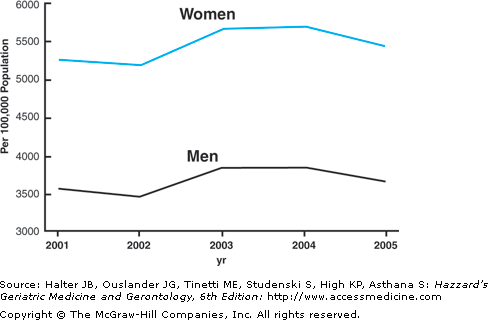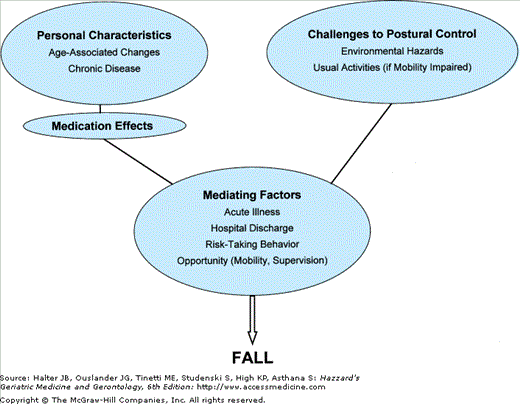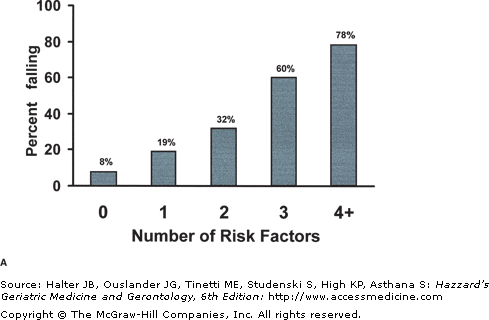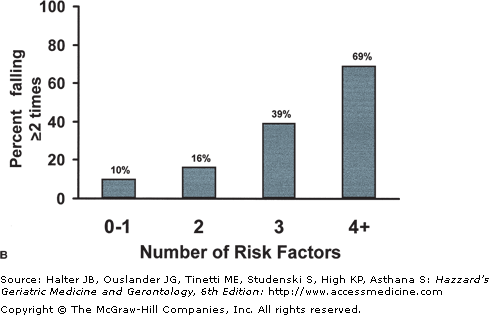Definition
Falls are common in older persons. A fall injury is costly in terms of morbidity, loss of physical function and independence, and mortality, as well as health care utilization. Falls have not always been recognized as a serious health problem. Prior to the 1940s, a fall was considered an unpredictable event that could not be prevented. In the past 20 years, however, research studies have shown the incidence and consequences of falls, revealed their multifactorial etiology, and demonstrated that they can be prevented by treating the factors that increase an older person’s risk of falling. Effective treatment requires a multidisciplinary approach. Perhaps because of this, fall prevention is not widely practiced in clinical settings outside of specialized geriatric assessment clinics; thus, falls remain an undertreated public health issue.
This chapter addresses nonsyncopal (Syncope is discussed in Chapter 57) falls—unintentional events in which a person comes to rest on the floor or ground that are not caused by loss of consciousness, stroke, seizure, or overwhelming force. Falls in three different settings—the community, skilled nursing facilities, and hospitals—are discussed; reasons for falling and, therefore, interventions differ by site.
Incidence and Consequences of Falls
Approximately 35% to 40% of persons age 65 years and over fall in a given year; half of persons who fall do so more than once. The incidence increases steadily after age 60 years; approximately 50% of persons aged 80 years and older fall in a year. Women are more likely to fall than men. More than half of all falls in the community happen at home. The rates for falls in skilled nursing facilities and hospitals are almost three times that for community-dwelling elders, and are estimated at 1.5 falls per bed per year.
Although young children and athletes also have a high incidence of falls, older persons are at high risk of injury with a fall because of age-related changes such as slow reaction time, impaired protective responses, and comorbid diseases such as osteoporosis. As a result, serious fall injuries, including fractures, lacerations, serious soft-tissue injuries, and head trauma, occur in 5% to 15% of falls in the community. Injury rates are higher, from 10% to 25% of falls, in institutional settings. Approximately 8% of persons aged 65 years and older visit an emergency department because of a fall-related injury each year; almost half of these persons are admitted to the hospital for treatment. In 2003, 1.8 million older persons were treated in an emergency department for nonfatal fall injuries. Fractures, most commonly of the hip, pelvis, femur, vertebrae, humerus, hand, forearm, leg, or ankle, occur in approximately 3% of falls. Conversely, falls account for 87% of all fractures and for more than 95% of hip fractures in this group. Falls are the second leading cause of brain and spinal cord injury in older adults. According to data from 2001 to 2005, the annual rates of nonfatal injuries are about 48% higher for women than men (Figure 54-1).
Figure 54-1.
Age-adjusted nonfatal fall injury rates among men and women aged 65 yrs and older, United States. Rates are per 100,000 people, age-adjusted to the 2000 U.S. population. (Redrawn from Centers for Disease Control and Prevention, National Center for Injury Prevention and Control. Web-based Injury Statistics Query and Reporting System (WISQARS), 2005. Available at: www.cdc.gov/ncipc/wisqars.)
Hip fractures are probably the most dreaded fall-related injury, as approximately half of older persons who sustain a hip fracture cannot return home or live independently after the fracture, and up to 20% die within a year of the fracture. Between 1993 and 2003, the age-adjusted hospitalization rate for hip fractures initially increased, then declined, with an overall rate of 775.5 per 100,000 people in 2003. The incidence of hip fracture is higher for women than men, but there was a decline of 20.8% in the hospitalization rate for hip fractures in women between 1993 and 2003, while that for men has remained the same.
In the United States, unintentional injury is the fifth leading cause of death in persons age 65 years and older; falls are the cause of two-thirds of the deaths resulting from injuries in this age group. In 2003, approximately 13 700 older persons died as the result of a fall. The age-adjusted death rate from falls increased significantly between 1993 and 2003, and men in this age group continue to have a significantly higher fatality rate than women (Figure 54-2).
Figure 54-2.
Age-adjusted fatal fall injury rates among men and women aged 65 yrs and older, United States. Rates are per 100,000 people, age-adjusted to the 2000 U.S. population. (Redrawn from Centers for Disease Control and Prevention, National Center for Injury Prevention and Control. Web-based Injury Statistics Query and Reporting System (WISQARS), 2005. Available at: www.cdc.gov/ncipc/wisqars.)
Falls are costly for older persons, both in terms of health care dollars and in loss of physical function and independence. Fall-related injuries account for approximately 6% of all health care expenses for persons aged 65 years and older in the United States. Falls also take a toll on an older person’s independence and quality of life. Falls account for approximately 20% of restricted activity days in older people—more than for any other health condition. In addition to immediate curtailment of activity, older persons who have a fall injury may restrict activity for several months or longer after the injury because of residual physical impairment or because of fear of falling again. Older persons are often unable to get up from the ground or floor after a fall, resulting in long lies with the risk of pneumonia, dehydration, and rhabdomyolysis. Fear of falling occurs in at least 50% of those who fall, and leads to restriction of activities in 10% to 25%. Finally, falls and fall injuries are a major determinant of nursing home placement.
Etiology of Falls and Fall Injuries
A fall occurs when a person’s center of gravity moves outside of their base of support and insufficient, ineffective, or no effort is made to restore balance. Classification schemes have been developed to explain how falls occur. One such scheme classified falls according to cause, namely extrinsic, or as a consequence of slips, trips, and other environmental factors that perturbed balance; intrinsic, or as a consequence of deficits in balance, mobility, cognitive or sensory function; nonbipedal falls, such as falling out of bed; or nonclassifiable falls. Falls have also been classified by most likely immediate cause, including environmental factors, balance or gait disorder, drop attack, dizziness, or postural hypotension. However, while observation may suggest that one factor predominates, more often it is the interaction of multiple factors that results in a fall (Figure 54-3). Intrinsic, personal characteristics, in conjunction with pharmacologic and behavioral factors, can alter resting balance or affect an older person’s postural responses to challenges posed by the environment, or posed simply by movements such as transfers or walking.
Prospective and retrospective community- and nursing home-based studies in the past 15 years have identified a number of factors that increase an older person’s risk of falling. Table 54-1 lists the most commonly identified factors. Studies show that the risk of falling increases with the number of risk factors a person has (Figure 54-4).
RISK FACTOR | SIGNIFICANT/TOTAL† | MEAN RR-OR‡ | RANGE |
|---|---|---|---|
Muscle weakness | 10/11 | 4.4 | 1.5–10.3 |
History of falls | 12/13 | 3.0 | 1.7–7.0 |
Gait deficit | 10/12 | 2.9 | 1.3–5.6 |
Balance deficit | 8/11 | 2.9 | 1.6–5.4 |
Use of assistive device | 8/8 | 2.6 | 1.2–4.6 |
Visual deficit | 6/12 | 2.5 | 1.6–3.5 |
Arthritis | 3/7 | 2.4 | 1.9–2.9 |
Activities of daily living (ADL) impairment | 8/9 | 2.3 | 1.5–3.1 |
Depression | 3/6 | 2.2 | 1.7–2.5 |
Cognitive impairment | 4/11 | 1.8 | 1.0–2.3 |
Age >80 yrs | 5/8 | 1.7 | 1.1–2.5 |
Figure 54-4.
The risk of falling increases with the number of risk factors present, both for single and recurrent falls. (A) Occurrence of falls, according to the number of risk factors, in a study of 336 persons older than age 75 yrs living in the community. Risk factors included sedative use, cognitive impairment, lower-extremity disability, palmomental reflex, foot problems, and balance/gait abnormalities. (Adapted with permission from Tinetti ME, Speechley M, Ginter SF. Risk factors for falls among elderly persons living in the community. N Engl J Med. 319:1701, 1988. Copyright ©1988 Massachusetts Medical Society. All rights reserved). (B) The proportion of subjects who fell more than two times increased with number of risk factors in a study of 325 community-dwelling persons older than age 60 yrs who had fallen in the previous year. Risk factors were difficulty standing up from a chair, difficulty with tandem walk, arthritis, Parkinson’s disease, more than three falls or a fall with injury in the previous year, and white race. (Data from Nevitt MC, Cummings SR, Kidd S, et al. Risk factors for recurrent nonsyncopal falls. A prospective study. JAMA 261:2663, 1989. Copyright © 1989, American Medical Association. All rights reserved.)
Age greater than 80 years, need for assistance with activities of daily living, and previous falls, indicate risk for future falls. While these characteristics cannot be modified, they serve as indicators for clinicians to pay increased attention to the presence of other, treatable risk factors for falls. The most important modifiable intrinsic risk factors for falls are balance, strength, and gait impairments. Impairment in these areas may be caused by a number of sensory, neurological, or musculoskeletal diseases, in addition to deconditioning as a result of lack of activity, age-related changes, and medication effect.
Balance, or postural control, is dependent upon the integration of visual, vestibular, and proprioceptive input by the central nervous system to effect an appropriate postural response to control the movement of the center of mass over the base of support, the feet. With quiet standing, there is little movement of the center of mass. The area over the feet within which a person is able to lean decreases with age. Fall risk has been linked to mediolateral instability; clinically this can be tested by the ability to stand in tandem stance or on one leg, both of which reduce the mediolateral base of support. The effect of impaired performance of static balance tasks may be manifested in activities such as walking and transferring. Persons who experience difficulty with standing balance tasks may walk more slowly and therefore spend a greater percentage of the gait cycle in more stable double stance with a wider base of support. Maintaining balance during body movements requires a reaction to restore the person’s displaced center of mass over the base of support. A loss of balance may be caused by the speed or magnitude of displacement, an inability to quickly detect the displacement because of sensory impairment, slowing of central nervous system integration of sensory information into a motor response, or muscle weakness or joint pain, causing an inadequate or ineffective response. Older persons take compensatory steps at lower levels of balance disturbance than young adults, but may have less effective stepping responses (multiple steps, difficulty controlling lateral stability) with greater challenges to balance. Older persons are slower than young adults in initiating reaching reactions to break a fall or grasp a handrail.
Sensory modalities that provide afferent input for balance responses include vision, hearing, proprioception, and vestibular function. Vision is affected by age and disease. While decreased visual acuity may be important, impaired contrast sensitivity (the ability to detect edges) and depth perception have been found to be the most significant visual risk factors for falls. Multifocal lenses, commonly worn by presbyopic older persons, are problematic because the lower, near-vision lenses impair distance depth perception in the lower visual field where tripping hazards would be seen. Cataracts, glaucoma, and macular degeneration affect vision and are common diseases in older persons. There is some evidence that first-cataract surgery can reduce fall risk. Hearing loss is found in more than 50% of older people, and can affect perception of and orientation to the environment. Vestibular function changes with age and with diseases affecting the inner ear. Impaired vestibular function can lead to loss of balance when there is decreased visual input as a consequence of disease, or as a result of environmental factors, such as movement in the dark. Mechanoreceptors in apophyseal joints and peripheral nerves provide proprioceptive input and may be affected by age, degenerative joint disease, cervical disorders such as spondylosis, or peripheral neuropathy. Proprioceptive dysfunction can result in loss of balance on uneven ground or in situations, such as walking in the dark, where there is decreased visual input.
Central nervous system processing of sensory input to initiate a postural response may be affected by neurological diseases such as Parkinson’s disease, stroke, or normal pressure hydrocephalus. Cognitive impairment caused by dementia may impair judgment and affect the perception and interpretation of sensory stimuli, resulting in falls even without the presence of a muscle or gait disorder. Depression may increase fall risk because of decreased concentration or awareness of potential environmental hazards.
Musculoskeletal impairments increase the risk of falling. Muscle mass and strength decline with age, disease, and inactivity. The older person may no longer be capable of generating the strength and accuracy of response to a balance disturbance (e.g., tripping) that is required. Loss of lower-extremity strength, in particular ankle dorsiflexor strength, has repeatedly been shown to be an important determinant of fall risk. Weakness of hip abductors and adductors may decrease an older person’s ability to maintain balance while stepping to avoid a fall. Musculoskeletal diseases such as osteoarthritis can cause pain, deformity, and limited range of motion in joints, particularly in the back, hips, knees, and feet that increase the risk for falls. Upper body arthritis or muscle weakness can affect an older person’s ability to break the impact of a fall, increasing the risk of injury such as a fracture. Foot problems, such as calluses, bunions, long nails, or joint deformity, can affect balance by compensatory strategies as a consequence of pain or impaired sensory input.
Postural hypotension, which may result in instability, occurs in 10% to 30% of community-dwelling older persons aged 65 years and older. A drop in systolic blood pressure of 20 mmHg or more with change in position from lying to standing may be medication-related, caused by dehydration, or a result of age-associated changes or diseases that affect autonomic control of vascular tone. Postprandial hypotension may be suspected in persons complaining of dizziness or who fall after getting up from, or soon after, a meal.
Outside |
Repair uneven pavement, cracked sidewalks |
Install railings for outdoor steps |
Use adequate lighting |
Keep shrubbery trimmed near walks |
Inside |
Floors |
Remove throw rugs |
Use nonskid carpet backing; tack down or tape carpet edges |
Avoid wax or use nonskid wax |
Mark high thresholds with reflective tape |
Remove clutter and furniture from traffic areas |
Keep electrical and telephone cords near walls, out of walkways |
Make sure that telephone can be reached from floor, or have emergency call device |
Lighting |
Adjust to decrease glare |
Have adequate lighting from bedroom to bathroom at night |
Have lights with switches at top and bottom of stairways |
Stairways |
Install railings on both sides, extending full length of stairs |
Make sure railings are secure |
Ensure stairs have nonskid surfaces and are free of clutter |
Mark top and bottom step with reflective tape |
Bathroom |














